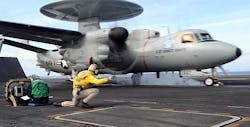Northrop Grumman prepares to build five E-2D Advanced Hawkeye carrier-based aircraft
PATUXENT RIVER NAS, Md., 8 July 2013. Aircraft designers at the Northrop Grumman Corp. Aerospace Systems sector in Bethpage, N.Y., are preparing to build an additional five E-2D Hawkeye carrier-based surveillance and early warning aircraft for the U.S. Navy.
Officials of the Naval Air Systems Command at Patuxent River Naval Air Station last week awarded Northrop Grumman a $9.3 million contract modification to procure long lead materials and related support for the full rate production of five E-2D Advanced Hawkeye Lot 2 radar aircraft.
An aircraft long-lead-item contract enables an aerospace manufacturer to buy components and equipment that typically take a long time to acquire so the company can complete the final aircraft as soon as possible after final contracts are awarded.
The E-2D Advanced Hawkeye is a twin-engine turboprop aircraft designed to take off and land on aircraft carriers. Its large saucer-like radar antenna mounted to the top of the aircraft enables it to detect hostile aircraft and missiles at extremely long ranges and vector Navy aircraft to intercept.
Northrop Grumman officials call the E-2D a "digital quarterback" to sweep ahead of Navy aircraft carrier strike groups, manage missions, and keep U.S. network-centric carrier battle groups out of harm's way. The aircraft provides battle management, theater air and missile defense, and multi-sensor fusion capabilities.
Compared with its E-2C predecessor, the E-2D has a completely new radar with mechanical and electronic scanning capabilities; glass cockpit; advanced identification friend or foe (IFF) system; new mission computer and tactical workstations; electronic support measures enhancements; an d modernized communications and data link suite, Northrop Grumman officials say.
The E-2D's capabilities include true 360-degree radar coverage for all-weather tracking and situational awareness; open-architecture commercial-off-the-shelf (COTS)-based hardware and software; network-enabled capability; and the ability to carry out missions ranging from command and control, missile defense, and border security.
The plane is nearly 58 feet long, has an 80-foot wingspan, can fly faster than 300 knots, and can fly to altitudes as high as 37.000 feet. It carriers a crew of five: two pilots and three mission systems operators. The co-pilot also can act as a fourth mission systems operator.
The E-2D first flew in 2007, and Navy officials say they hope to procure 73 of these aircraft by 2022. Full-rate production of the E-2D is scheduled for this year, and the aircraft should go to the fleet in 2015.
Historically Northrop Grumman has managed the E-2 program from its facility in Bethpage, N.Y., but the company will assemble the aircraft in Melbourne, Fla. The company no longer builds aircraft at its Bethpage facility.
On the current contract Northrop Grumman will do the work in Syracuse, N.Y.; Bethpage, N.Y.; El Segundo, Calif.; Chicago; Menlo Park, Calif.; Indianapolis; Cleveland; Aire-Sur-L’Adour, France; Owego, N.Y.; Torrance, Calif.; Edgewood, N.Y.; Falls Church, Va.; and at other locations throughout the United States, and should be finished in March 2014.
For more information contact Northrop Grumman Aerospace online at www.northropgrumman.com, or Naval Air Systems Command at www.navair.navy.mil.

